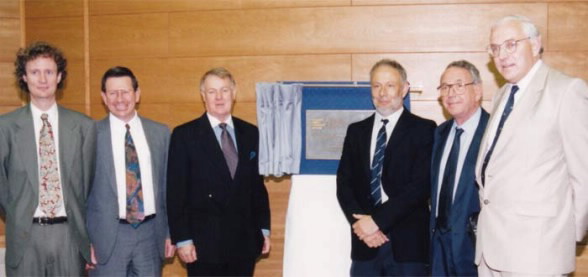Since 1992, the high-tech Photon Factory in Tsukuba, 50 kilometres northeast of Tokyo, has been home to a highly significant piece of Australian research infrastructure called the Australian National Beamline Facility (ANBF).
 |
| Australian members of the ANBF project at the official opening at the Photon Factory in 1993. L-R Dr Richard Garrett, Professor John Boldeman, Professor Dudley Creagh, Dr Steve Wilkins, Professor Hans Freeman and Professor John White. |
The ANBF was a visionary project that enabled Australian researchers to use a dedicated synchrotron beamline for the first time, enabling access without being hampered by long lead-times required for access to overseas synchrotrons.
After more than twenty years of service, the ANBF will be retired in March and its iconic instrument, an in-vacuum diffractometer dubbed “Big Diff”, will head back to Australian shores where it will be displayed at the Australian Synchrotron in Victoria as a reminder of the early days of synchrotron science in Australia.
Synchrotrons accelerate electrons that produce intense beams of light and X-rays to study matter at the atomic scale. Throughout the 1980s, Synchrotron science was at the cusp of a range of cutting edge materials, environmental, bio-medical and mineral science in the UK, Europe, Asia and the USA.
Keen to ensure Australian researchers kept up with these revolutionary new capabilities, a group of eminent Australian scientists prompted the federal government to entrust ANSTO with establishing a dedicated Australian beamline at the Photon Factory synchrotron light source at the KEK Laboratory in Tsukuba, Japan.
The infrastructure was designed and built in Australia at ADFA in Canberra and the CSIRO then Division of Materials Science and Technology in Melbourne, and managed in Japan by three young scientists from ANSTO: Richard Garrett, David Cookson and Gary Foran.
“You have to start off in the sandbox before you can build a three-ring circus,” David Cookson says.
“The ‘Big Diff’ and other instrumentation on the ANBF have been an important training ground – a sandbox if you like – for Australian synchrotron science.
“That said, the facility held its own for 20 years and, thanks to successive beamline staff, hosted thousands of visiting researchers and produced world-class science.
“A lot of what we did here was very innovative: we were developing and using techniques that now require highly-specialised, dedicated synchrotron beamlines.”
The Big Diff enabled researchers to analyse samples using x-ray diffraction, reflectometry and phase contrast imaging: the latter being an ultra-high-contrast version of x-ray images you get from a radiographer.
As the years went by, the experimental instrumentation was continually upgraded and other techniques such as x-ray spectroscopy started to dominate at the ANBF, although the Big Diff is still occasionally called into service for some experiments.
“The ANBF was the first important step along the path to the Australian Synchrotron”, said Richard Garrett.
“The success of the ANBF program led directly to the expanded Australian Synchrotron Research Program (which added access to facilities in the USA and Taiwan).
“This has trained a whole generation of Australian scientists and laid the groundwork for the construction of Australia’s own synchrotron, with many of the leading users of the Australian Synchrotron cutting their teeth on the ANBF.
“Australian science owes an enormous debt of gratitude to Japan and the Photon Factory for their generous support over all these years.”
The ANBF ushered in a significant chapter in Australia’s scientific relationship with Japan. It led to high profile collaborations between the two nations in synchrotron and neutron science, including when the two countries worked together to establish regional Asia Oceania networks in both these fields.
But all good things must come to an end, and the ANBF will be retired from service in March to make way for newer facilities.
Andrew Peele, Interim Director of the Australian Synchrotron, points out it is important to recognise the contributions of the past that have paved the way for the Australian Synchrotron becoming a premier research facility in Australia.
“The venerable Big Diff will be transported back to Australia where it will be displayed at the Australian Synchrotron as a reminder of Australia’s scientific spirit,” said Andrew Peele.
“The final experiments at the ANBF are currently underway, and the 20 plus years of this extraordinarily successful collaboration will be commemorated at an official ceremony hosted by the Photon Factory in Tsukuba on March 15.”
And what of the three young physicists who built the ANBF in Japan? After years operating the ANBF beamline and acting as an advisor to the Australian Synchrotron, Garry Foran now works for another research agency in Japan, Richard Garrett is ANSTO’s senior advisor in synchrotron science, and David Cookson is Head of Beamline Science and Operations at the Australian Synchrotron in Melbourne.
Published: 25/02/2013

